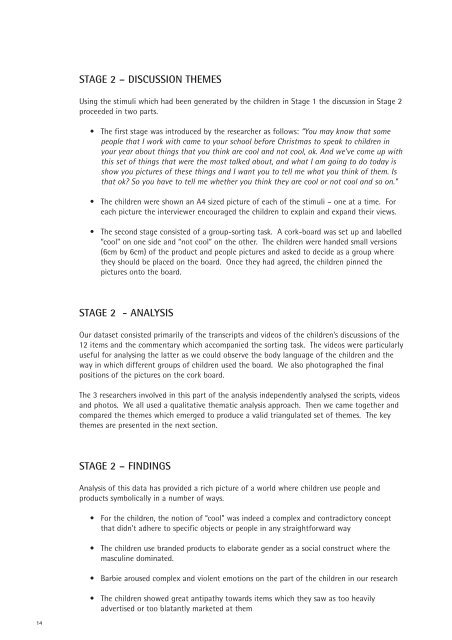The Simpsons are Cool but Barbie's a Minger - Professor Agnes Nairn
The Simpsons are Cool but Barbie's a Minger - Professor Agnes Nairn
The Simpsons are Cool but Barbie's a Minger - Professor Agnes Nairn
Create successful ePaper yourself
Turn your PDF publications into a flip-book with our unique Google optimized e-Paper software.
14<br />
STAGE 2 – DISCUSSION THEMES<br />
Using the stimuli which had been generated by the children in Stage 1 the discussion in Stage 2<br />
proceeded in two parts.<br />
• <strong>The</strong> first stage was introduced by the researcher as follows: “You may know that some<br />
people that I work with came to your school before Christmas to speak to children in<br />
your year about things that you think <strong>are</strong> cool and not cool, ok. And we’ve come up with<br />
this set of things that were the most talked about, and what I am going to do today is<br />
show you pictures of these things and I want you to tell me what you think of them. Is<br />
that ok? So you have to tell me whether you think they <strong>are</strong> cool or not cool and so on.”<br />
• <strong>The</strong> children were shown an A4 sized picture of each of the stimuli – one at a time. For<br />
each picture the interviewer encouraged the children to explain and expand their views.<br />
• <strong>The</strong> second stage consisted of a group-sorting task. A cork-board was set up and labelled<br />
“cool” on one side and “not cool” on the other. <strong>The</strong> children were handed small versions<br />
(6cm by 6cm) of the product and people pictures and asked to decide as a group where<br />
they should be placed on the board. Once they had agreed, the children pinned the<br />
pictures onto the board.<br />
STAGE 2 - ANALYSIS<br />
Our dataset consisted primarily of the transcripts and videos of the children’s discussions of the<br />
12 items and the commentary which accompanied the sorting task. <strong>The</strong> videos were particularly<br />
useful for analysing the latter as we could observe the body language of the children and the<br />
way in which different groups of children used the board. We also photographed the final<br />
positions of the pictures on the cork board.<br />
<strong>The</strong> 3 researchers involved in this part of the analysis independently analysed the scripts, videos<br />
and photos. We all used a qualitative thematic analysis approach. <strong>The</strong>n we came together and<br />
comp<strong>are</strong>d the themes which emerged to produce a valid triangulated set of themes. <strong>The</strong> key<br />
themes <strong>are</strong> presented in the next section.<br />
STAGE 2 – FINDINGS<br />
Analysis of this data has provided a rich picture of a world where children use people and<br />
products symbolically in a number of ways.<br />
• For the children, the notion of “cool” was indeed a complex and contradictory concept<br />
that didn’t adhere to specific objects or people in any straightforward way<br />
• <strong>The</strong> children use branded products to elaborate gender as a social construct where the<br />
masculine dominated.<br />
• Barbie aroused complex and violent emotions on the part of the children in our research<br />
• <strong>The</strong> children showed great antipathy towards items which they saw as too heavily<br />
advertised or too blatantly marketed at them


